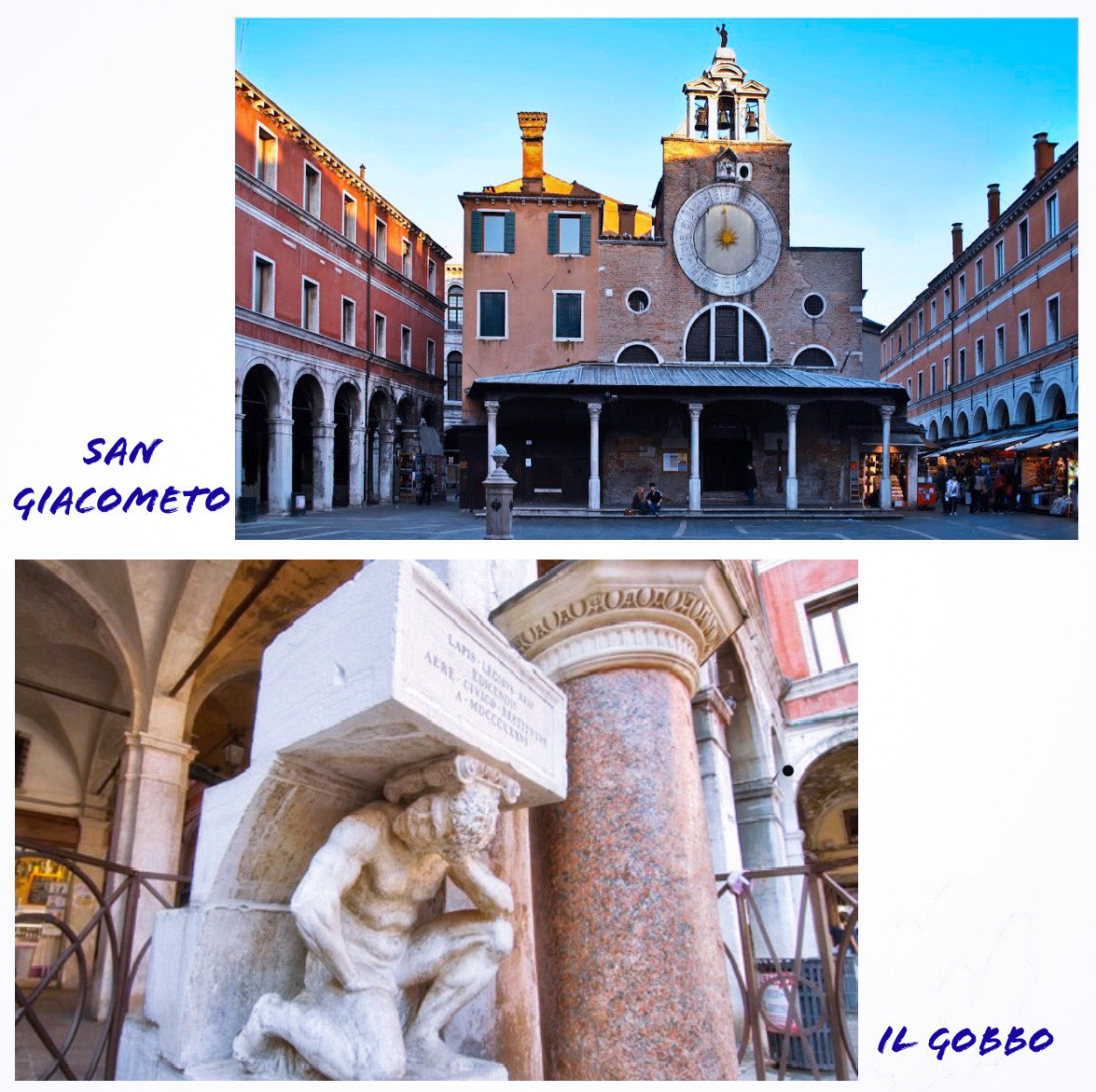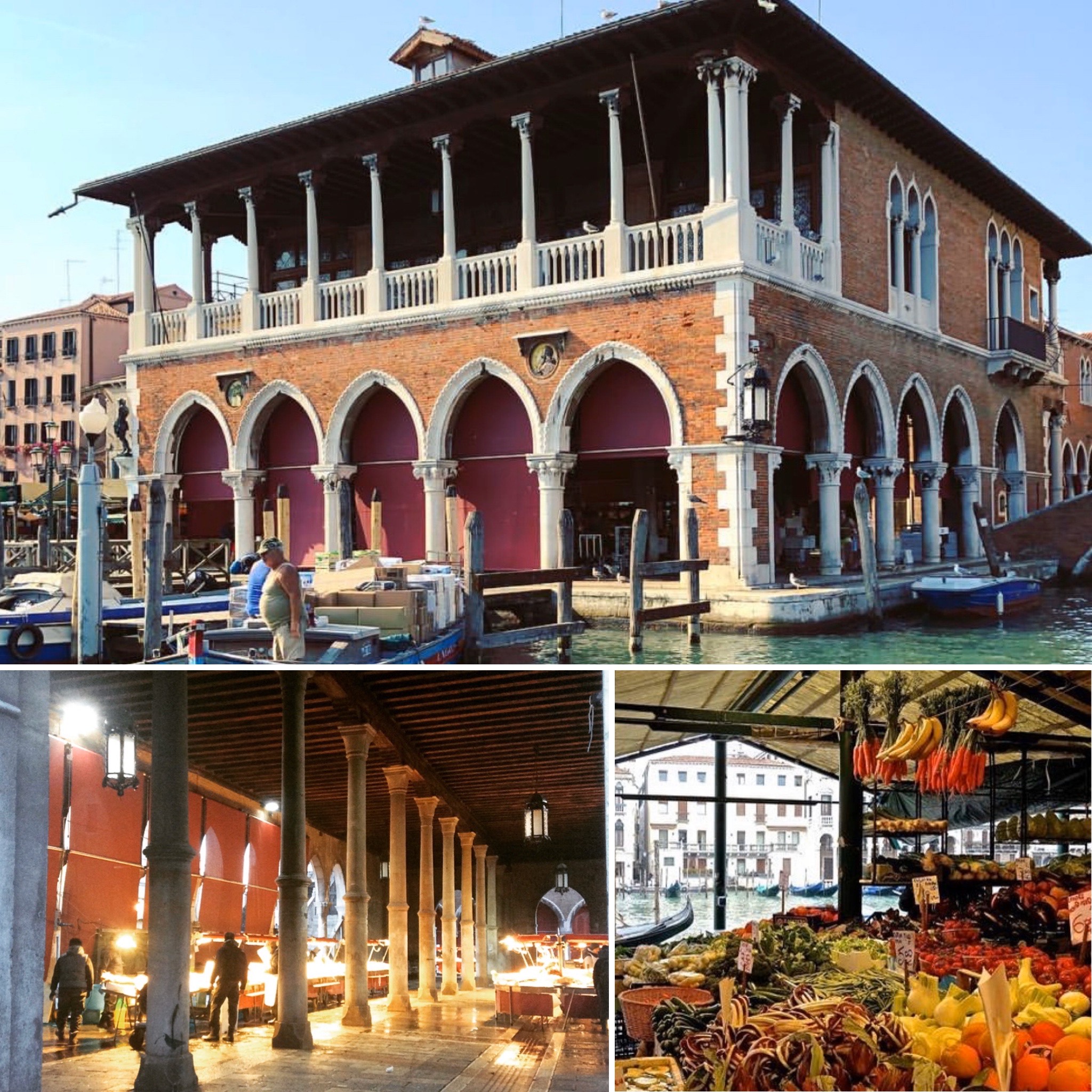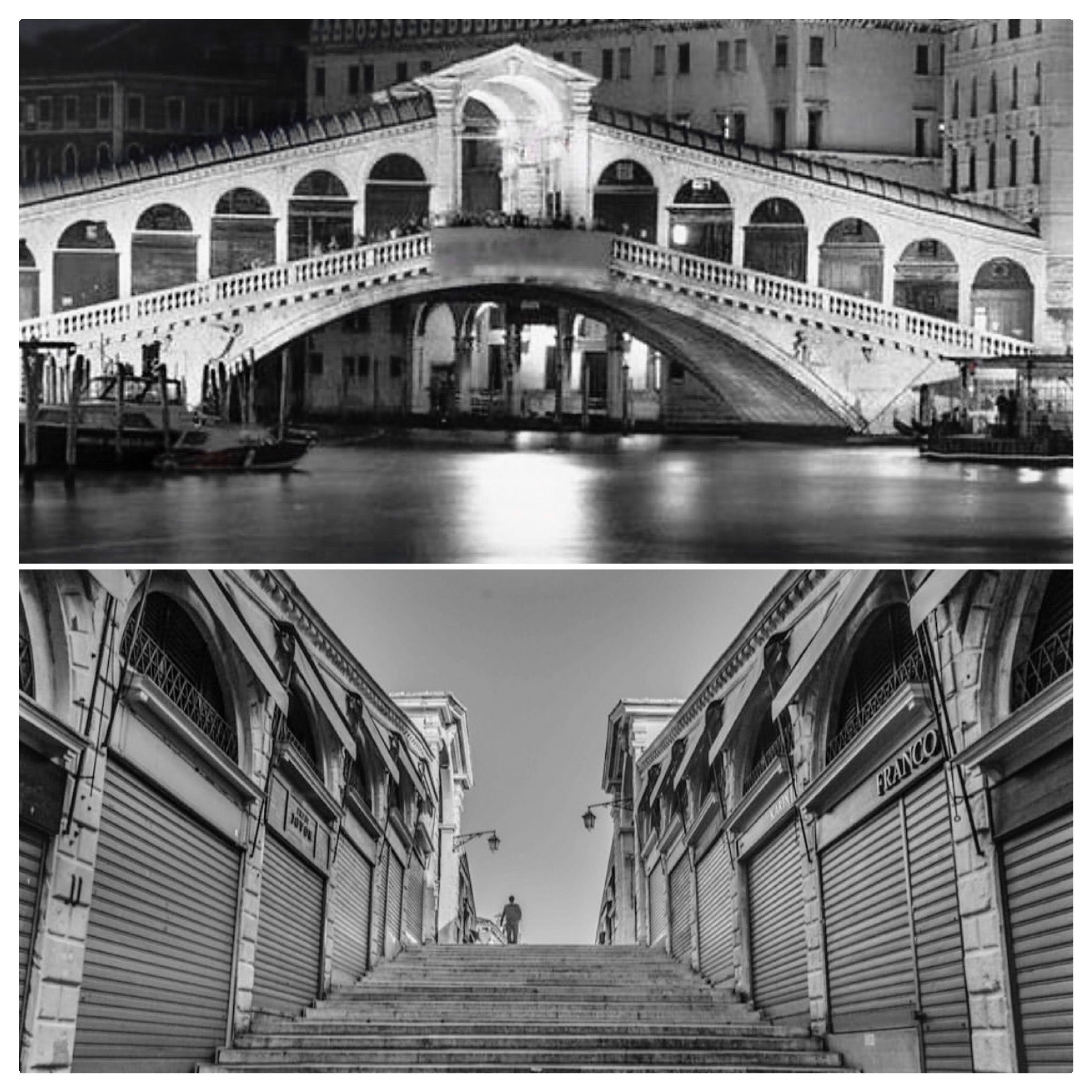The beginning: this is where the Venetian myth was born

When one thinks of Venice one always thinks of the Rialto Bridge, which seems to rise from the waters of the Canale Grande, so particular in its structure, with its shops.
But Rialto is much more. It is the oldest part of Venice, the first settlement called Rivo Altus which gave way to the birth of the Venetian myth. Already, a singular name that indicated that at that point, just where the Grand Canal bends in its first curve, the ground was harder and higher. Beautiful! Too bad the weather changes things and now this same area is one of the first to "go under" (flood) when the tide of the Lagoon rises more than it should.
And on this piece of land the first small urban group settles on the right bank. And as proof of this, it is precisely the structure of the still existing blocks between Ruga Vecchia and Riva del Vin, between Ruga degli Spezieri and Pescaria: here the city's plot is a comb, with long blocks alternating with narrow streets, and has remained unchanged over the centuries. And it is here that the Church of San Giacometo rises, in the homonymous Campo, which seems to be the most ancient building of worship in the city, dating back even to the fifth century, even if the current structure is instead the result of an XI or 12th century. Wanted as a vote by a certain Candioto or Eutinopo elapsed with the Holy to subdue a fire, it has a cross-shaped plant surmounted by a dome, with a sober and linear interior although rich in marbles. But the interesting part is undoubtedly the exterior with its three most connotative elements: the Gothic fourteenth-century portico that protects the entrance and projects towards the Campo, a very rare example here in Venice; the bell tower which does not give impetus to the façade but ends with an elegant marble structure surmounted by the statue of the Saint; and the round and large-sized watch that became the protagonist of the façade marked the hours of the day's activities.
An important place was the realty nucleus and in the Campo della Chiesa di San Giacometo the laws and decisions that the state took, especially the death sentences, were announced with a loud voice. These were read to the population by the heralds from the top of a stump of a granite column, the stone of the proclamation, which was accessed thanks to a small marble staircase supported by the sculpture of a bent man in action, and therefore renamed by the Venetians "hunchback of Rialto". This statue was also the goal that the thieves had to reach in the sixteenth century, condemned to run naked from the columns of San Marco and San Teodoro, from the Piazzetta San Marco, along the Mercerie between two wings of a crowd that threw atrocious frustrated soaked in sulfur. Think of what suffering! It was so much the pain that the criminals once reached the statue, and then at the end of that terrible path, embraced and kissed the hunchback. But the priests of the neighboring church shouted at the idolatry of a pagan symbol and asked, and obtained from the Council of Ten, that the end of that path would become a Christian symbol. It was then that a metal cross was inserted in the first pillar, to the left, of the colonnade behind the hunchback and it was there that the thieves had to address their thanks. In reality this is a simple story behind which lies a more complex motivation. Beginning in the sixteenth century, we are in an extremely delicate historical period in which Venice had the widest territorial extension of its history and was also the most long-lived autonomous state, and therefore the rest of Europe decided to stop the unstoppable rise of the Republic. Without going into the details of the story, but know that Venice came out with broken bones, or we can say that the lion's wings were broken. Then to revive the fate of the Serenissima, a term coined precisely in those years, the State did not act militarily but worked ideologically on the myth of its origin. It was therefore chosen as the date of foundation on March 25th, an extremely symbolic date being the day of the Calvary and of the crucifixion of Christ who thus redeems all of humanity. With this Venice "put on record" his direct divine descent, becoming an emblem of the law and of otherworldly justice. From this point of view, therefore, that journey from San Marco to Rialto of thieves completely changes its meaning, thus representing a path of redemption and salvation, as was the Calvary of Christ, and certainly could not end with a symbol pagan, but a Christian representation was needed, which reincarnated the new divine myth of Venice: and the cross is the only symbol of possible redemption. Above that cross is the sign of St. Mark, precisely to represent divine justice on earth.
And can you find the cross?
The Rialto market yesterday and today: sounds, colors and scents of the most genuine Venetian tradit

Rivo Altus grew over time and increased its importance because in this nucleus trade was practiced. It became the commercial and merchant heart of Venice, which was contrasted with the administrative and ecclesiastical heart of Piazza San Marco. The Serenissima became rich and powerful here, in Rialto, between narrow streets and wide fields where merchant activities took place, where merchants came from all over the world for business and trade in goods: a very international market, where the sound of foreign languages echoed by now familiar, like a prototype of a European city.
Here in Rialto the functions were not only commercial but also bureaucratic, the financial magistracies. There was the mercantile forum with the benches on which they held business, the public steelyard which established the measures and duties of the fish, the fondaco of flour. Along the banks of the Grand Canal, iron and coal were sold and landings for the wine trade for the Malvasia were positioned: this is why now the sides of the bridge are the Riva del Carbon, the Riva del Vin, the Riva del Ferro . In the inner streets, called wrinkles due to the presence of shops, all the specialized commercial activities took place. The most famous was Ruga de i Spezieri, a fundamental stop on the famous "via delle spezie": it was here that the precious and expensive spices from the maritime trade arrived that the Serenissima wove with the world of Levante. It is here that the "Venetian sacheti of speciarie", ready-to-use products, were prepared. And it is from here that the Serenissima practiced the traffic and their diffusion for the rest of Europe. On the whole market, considered a real treasure, they supervised the magistracies for the correctness of the carrying out of activities and business.
This happy island was defined as "the richest part of the world". But on 10 January 1514 a fire developed from a shop sent everything up in smoke, accomplices of a north wind and the waters of the Grand Canal frosts. A dramatic moment but the realtino heart managed to rise up with an incredible reconstruction that led to the transformation of the area. All not without a great debate, as always happens in case of change. The structure of the market was outlined in a precise and orderly manner, organized to optimize spaces and simplify the performance of activities. A structure that still lives in this part of the city. Buildings of equal height were built, a square field and the margins facing the banks were left open. Under the arcades were the goldsmiths' shops that traded gold and precious stones, also required for their magical and therapeutic powers; in the Campo di Rialto, called Erbaria, the vegetable stalls were placed, at Naranseria, orangery, citrus and fruit were traded, in the Campo de le Beccarie meat and poultry. Fresh fish arrived in the Pescaria lodges, now protected by a Neoclassical-style twentieth-century structure built with a loggia on the ground floor where the market takes place, and whose columns are adorned with sculptures that bear the semblance of various sea creatures, while the interior is closed with a typical Venetian wooden beam ceiling; the upper floor is partly closed and partly opens with a magnificent terrace on the Grand Canal. Outside the entrance a marble stele shows the names in Venetian, the sizes and the minimum weights of the sold fish.
All around were the warehouses for the richest goods, so many taverns for the refreshment of the workers and the inns for the overnight stay of foreign merchants.
The Rialto market has not changed much since then, still extremely lively and colorful, flooded with sounds and fragrances, where the foreign voices of the merchants have been replaced by those of the many tourists who choose to visit it and who join those of the Venetians, in a cheerful and timeless sound amalgam. It is perhaps the most genuine heart of the city, where you can meet the true everyday life of this community, which brings back to the correct dimension of a cosmopolitan and international city that has always been, as history has taught us.
Go to the Rialto market early in the morning, immerse yourself in this crazy normality, let yourself be deafened by the thousand voices and transported by the scents, fill your eyes with the many colors, chat with the sellers. Come back in the evening for a dinner or simply for a spritz, there where the Grand Canal gets narrower enough to seem to touch the opposite shore, in the shadow of his majesty the Rialto Bridge.
A day & night experience, between cheerful madness and romance.
The Rialto Bridge: the story of bold engineering, devil and sacrificed souls

His Majesty the Rialto Bridge! Which challenged the invisible forces of statics and the intervention of the Devil to reach us with its load of historical events and legendary narratives.
It is a great thrill to arrive in Venice, follow the Grand Canal and pass under its immense arch. When he is at his feet he paws for the desire to run up, admire the city from such a high point. But perhaps not everyone knows that the one in Rialto was absolutely the first bridge built in Venice, in a historical and urbanistic moment in which the connections were exclusively water. As we said in the previous paragraph in the heart of the market, trade was practiced and so was the traffic of merchants and artisans, who also needed a continuous shift from one bank to the other of the Canal. This happened thanks to gondolas paying a quartarolo, a quarter of the Venetian coin of that time. Inconvenient to say, let alone to be done, and then it was thought to create a direct connection, which would allow to move freely from one to the other shore. We are in 1175 and immediately the easiest solution was chosen, that is a bridge built with the juxtaposition of boats held together by wooden boards and poles. Ten years later it was replaced by a structure built by Nicolò Baretieri partly supported by poles and partly suspended on the Canal, which was given the name of "Quartarolo", just like the money paid to be ferried from one shore to the other. other.
But with the growth of Rialto as the heart of the economy and commerce that passage became indispensable and therefore it was decided to create a much more solid and lasting structure: the first Rialto Bridge was built, again in wood, with two banks and with the central part able to rise to allow the passage of the ships with the high tree but above all to allow the navigation of the Bucintoro on which Doge traveled. This bridge is true that supported the intense trafficking of artisans and sellers, but also ensured the link with San Marco, the nerve center of the policy of the Serenissima. Subject to excessive use and therefore to continuous maintenance interventions, in 1458 benches and shops were added to the edges of the deck, which then became a characteristic sign of the bridge: the rents of these commercial spaces, paid to the State Treasury, served for frequent maintenance of the bridge. But they were not enough, and the bridge collapsed several times, to the point of recording two victims in the sixteenth century.
These events led to the decision to build a solid, durable stone structure. We are just beyond the second half of the sixteenth century and a competition was held to which many well-known artists of the time participated, including Michelangelo, Sansovino, Scamozzi and Palladio, whose project can be admired in a famous caprice of Canaletto's artist. But the winner was Antonio da Ponte (when he says the name is an omen) as he was the only one who designed a bridge solution with a single span, which made the architectural line elegant and sinuous, which gently caressed the water until it was immersed. But the idea of Antonio da Ponte was not only an aesthetic choice, but above all static and practical, as it allowed a free and simple navigation under his deck.
The new bridge had a single arch of 28 meters of rope ("radius" of the arch) supported by 12 thousand poles in elm wood embedded in the subsoil for the foundations and divided into three ramps: the central one 10 meters wide, with its wide steps leading up to the highest point, where two "triumphal arches" surmounted by a triangular cornice allow the connection with the two narrower side ramps, of about 3 meters each, which allow the gaze of those who walk to embrace the city on both sides, in a singular set of always different perspectives and points of view. Twenty-four shops are located between the central ramp and the two lateral ones, all ending with arched cornices which together with the central one create a geometric but soft architectural continuity: they are a reminder of the past but also a pleasant preface for the commercial area placed at the foot of the two banks.
In addition to the architectural elements, the Rialto Bridge is not adorned with many decorations, but all the decorations are reserved for the banks facing the Grand Canal: on one side we find the sculptures of the Annunciation with the Archangel Gabriel and the Virgin Mary, work by Agostino Rubini; on the other the sculptures of San Marco and San Teodoro, the two protectors of the city sculpted by Tiziano Aspetti.
The legend that accompanies the construction of the bridge tells of great skepticism and perplexity on the part of the Venetians for this structure with a single arch suspended over the water, considering the proposal excessively audacious. Women who promised to burn their parts the intimate if the bridge had remained standing, and men who waited for the construction of the bridge of this kind only when their member had put the nail. This skepticism is today possible to admire it having remained carved in the capitals of the Palazzo dei Camerleghi at the foot of the bridge before arriving at the Campo di San Giacometo: an old woman with wings and legs of an animal that, when sitting, lets her private parts burn and a man with three legs clawed.
But popular disbelief even disturbed Lucifer, whom the Venetians called Saracino: it seems that the Saracen was revealed to Antonio da Ponte asking him in exchange for the soul of the person who would first cross the bridge in exchange for the success of the project. Da Ponte, believing himself clever, he made sure that the first soul was that of a living being, or a rooster. The devil, having discovered the deceit, disguised himself as a good man and visited the artist's pregnant wife, telling her that her husband was waiting for her beyond the bridge. The woman believed in his words and went: "the barter of souls sacrificed to success, those of the wife and son of the young artist, who cannot find peace and still wander on the bridge on cold nights, is inevitable" ...
But it is at night that the Rialto Bridge reveals its most extraordinary magic!










Lascia un commento